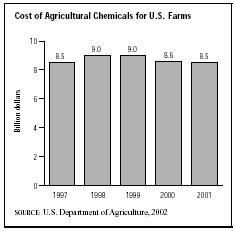SIC 0721
CROP PLANTING, CULTIVATING, AND PROTECTING
This group covers establishments primarily engaged in performing crop planting, cultivating, and protecting services. Establishments engaged in complete maintenance of citrus groves, orchards, and vineyards are classified in SIC 0762: Farm Management Services.
NAICS Code(s)
481219 (Other Nonscheduled Air Transportation)
115112 (Soil Preparation, Planting and Cultivating)
The crop planting, cultivating, and protecting industry encompasses a variety of services, including: aerial dusting and spraying; bracing of orchard trees and vines; citrus grove cultivation; corn detasseling; hoeing; insect control for crops, with or without fertilizing; irrigation system operation; planting crops; pruning orchard trees and vines; weed control; and other miscellaneous activities. The highly fragmented industry is dominated by small, private, local companies. As a result, statistical data on this group is scant.
Most industry activities, such as corn detasseling and hoeing, are relatively self-explanatory. One of the larger and more complex services is aerial application, or crop dusting, which usually entails dusting or spraying crops of large acreage with pesticides and weed control chemicals from an airplane. Aerial application is used for more than 65 percent of crop chemical applications in the United States, according to the National Agricultural Aviation Association (NAAA). Besides increasing the speed and efficiency of the dusting process, aerial crop dusting eliminates the need to apply chemicals with wheeled vehicles that could damage crops. The crop dusting industry faced repeated shutdowns in 2001 after the September 11 terrorist attacks raised concerns that crop dusters could be used to spread biological contaminants.
The need for crop services is an indicator of the trend toward advanced, large-scale farming practices that accelerated during the post-World War II U.S. economic expansion. During the 1950s, 1960s, and 1970s, U.S. farms became increasingly mechanized to take advantage of economies of scale. Importantly, the development of advanced pesticides, herbicides, fertilizers, and other chemical treatments resulted in an entire chemical application services industry. Likewise, new machinery significantly increased the amount of cultivated land which a single landowner could efficiently manage. Aerial crop dusting, performed as early as the 1920s using World War I surplus aircraft, for example, gave way to advanced higher-altitude craft by the early 1950s.
Indeed, while farmers during the early 1900s usually performed most crop management activities, many farm owners in the 1990s are more business owners and managers than conventional farmers. Farm owners commonly contract planting and seeding, irrigation, pest control, and other duties to specialized outside service providers.
The trend toward greater farm automation continued into the late 1990s and early 2000s. Aerial crop dusting, for example, became a complex, high-tech endeavor, with advanced crop dusting systems employing global positioning systems (GPS) to indicate precise location and to show which rows of crops need dusting. These modern systems are more efficient than the previously used flagging system, which required flag men on the ground to communicate where spraying or dusting was needed. Modern aerial dusters, which cost anywhere between $100,000 and $500,000, also benefit from on-board computers that automatically control spray width and coverage density. Computer systems are also capable of plotting fields and provide information about the best path for dusting a certain area, taking into consideration applicable weather conditions. Crop dusters also use computers to keep track of the types and amounts of chemicals used, as well as when and where they were sprayed.
Environmental safety of crop protection products (chemicals used to control insects, diseases, and/or weeds) became an increasingly important focus in the 1990s and 2000s. According to a report released by the National Center for Food and Agriculture Policy in November of 2000, pesticide sales in the United States increased 93.7 million pounds between 1992 and 1997, the latest year for which specific data is available. Fungicides, herbicides, insecticides, and other pesticides were also on the rise, making this industry, and its impact on the environment, a significant public concern. While the Food Quality Protection Act, signed into law in August 1996, provided some significant changes in food safety and pesticide laws, including major revisions in pesticide

registration and use provisions of chemicals, pesticide use remained a controversial issue in the early 2000s.
In the late 1990s and early 2000s, state representatives continued to promote legislation regulating pesticide use, and despite a 1997 report by the Environmental Protection Agency (EPA) that indicated pesticide usage among U.S. farms had dropped significantly since the all-time high in 1979, activist groups contended that pesticide use was on the rise, and controversy over the safety of pesticides grew stronger. The U.S. Department of Agriculture reported that between 1999 and 2001, total farm expenditures on agricultural chemicals declined from $9 billion to $8.5 billion. CropLife America, formerly known as the American Crop Protection Association (ACPA), an organization to which most major pesticide manufacturers and distributors belong, has been instrumental in providing information on regulatory changes as well as promoting the environmentally sound use of crop protection products. The ACPA notes that pesticides used on U.S. farm fields are rigorously tested, and only about one out of 20,000 pesticides is approved for usage on crops. Still, such groups as the Environmental Working Group and Pesticide Action Network North America lobby for more stringent controls on pesticide use and advocate less toxic pest control methods, such as crop rotation, introduction of beneficial insects, mulching, and use of low-toxicity pesticides such as sulfur, soaps, and biopesticides.
Further Reading
"Crop Dusters Cleared for Takeoff." United Press International, 25 September 2001.
National Center for Food and Agriculture Policy. "Trends in Crop Pesticide Use." November 2000. Available from http://www.ncfap.org/ncfap/trendsreport.pdf .
U.S. Department of Agriculture Economic Research Service. "Farm Production Expenses." 2002. Available from http://www.usda.gov/nass/pubs/stathigh/2003/tables/economics.htm .
Comment about this article, ask questions, or add new information about this topic: